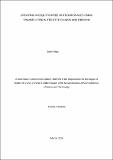| dc.contributor.author | Paliga, John | |
| dc.date.accessioned | 2020-11-18T08:52:45Z | |
| dc.date.available | 2020-11-18T08:52:45Z | |
| dc.date.issued | 2020-03 | |
| dc.identifier.uri | https://doi.org/10.58694/20.500.12479/1007 | |
| dc.description | A Dissertation Submitted in Partial Fulfillment of the Requirement for the Degree of
Master of Science in Public Health Research of the Nelson Mandela African Institution
of Science and Technology | en_US |
| dc.description.abstract | Residents of malaria-endemic communities spend several hours outdoors performing
different activities such as cooking, story-telling or eating; thereby exposing themselves to
potentially-infectious mosquitoes. This compromises indoor interventions, notably longlasting
insecticide-treated nets (LLINs) and indoor residual spraying (IRS). This study
characterized common peri-domestic spaces in rural south-eastern Tanzania, and assessed
protective efficacies of transluthrin-treated chairs and hessian ribbons against mosquitoes.
Two hundred households were surveyed, and their most-used peri-domestic spaces physically
characterized. Protective efficacies of these two prototyped interventions were tested outdoor
in 28 households in dry and wet seasons, using volunteer-occupied exposure-free double net
traps. Center for Diseases Control and Prevention miniature light traps (CDC-LT) were used
to estimate host-seeking mosquito densities within outdoor kitchens. Field-collected
Anopheles arabiensis and Anopheles funestus mosquitoes were exposed underneath the chairs
to estimate 24h-mortality. Approximately half (52%) of houses had verandas. Aside from
these verandas, most houses also had peri-domestic spaces where residents stayed most times
(67% of houses with verandas and 94% of non-veranda houses). Transfluthrin-treated chairs
reduced outdoor-biting An. arabiensis densities by 70-85
% while transfluthrin-treated hessian
ribbons caused 77-81% reduction in the general peri-domestic area. Field-collected An.
arabiensis (99.4%) and An. funestus (100%) exposed under transfluthrin-treated chairs died.
Most houses had actively-used peri-domestic spaces where exposure to mosquitoes occurred.
The transfluthrin-treated chairs and ribbons reduced outdoor-biting malaria vectors in these
peri-domestic spaces, and also elicited significant mortality among pyrethroid-resistant fieldcaught
malaria vectors. These two new prototypes, if developed further, may constitute new
options for complementing LLINs and IRS with outdoor protection against malaria and other
mosquito-borne pathogens in areas where peri-domestic human activities are common. | en_US |
| dc.language.iso | en | en_US |
| dc.publisher | NM-AIST | en_US |
| dc.rights | Attribution-NonCommercial-ShareAlike 4.0 International | * |
| dc.rights.uri | http://creativecommons.org/licenses/by-nc-sa/4.0/ | * |
| dc.subject | Peri-domestic spaces | en_US |
| dc.subject | Transfluthrin-treated chairs | en_US |
| dc.subject | Hessian ribbons | en_US |
| dc.subject | Spatial repellents | en_US |
| dc.subject | Outdoor-biting | en_US |
| dc.subject | Malaria vectors | en_US |
| dc.title | Creating mosquito-free outdoor spaces using transfluthrin-treated chairs and ribbons | en_US |
| dc.type | Thesis | en_US |


